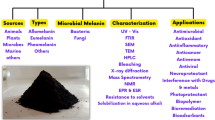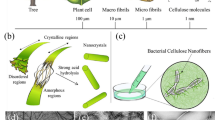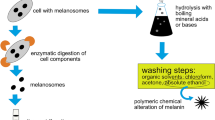Abstract
Natural and synthetic melanins are promising pigments for several uses, such as biosorbents and bioadhesives. Further, their high biocompatibilities and excellent biological activities potentially allow them to be ideal biomaterials for environmental and biotechnological applications. Naturally occurring melanin has been used as a biosorbent for the environmental treatment of organic chemicals and for metal ion removal, and melanins have been chemically engineered to function more efficiently. In addition, melanin has been engineered for use as an adhesive coating material, and its polymeric properties have been enhanced for medical applications. Clearly, given melanin’s high biocompatibility and biodegradability, it is a very viable biopolymer for further applications in environmental biotechnology fields. In this review, we highlight the uses of melanin as a biosorbent and bioadhesive in biotechnology fields.
Similar content being viewed by others
References
Park, J., H. Moon, and S. Hong (2019) Recent advances in melanin-like nanomaterials in biomedical applications: a mini review. Biomater. Res. 23: 24.
Caldas, M., A. C. Santos, F. Veiga, R. Rebelo, R. L. Reis, and V. M. Correlo (2020) Melanin nanoparticles as a promising tool for biomedical applications — a review. Acta Biomater. 105: 26–43.
Patel, R. P., M. R. Okun, L. M. Edelstein, and D. Epstein (1971) Biochemical studies of the peroxidase-mediated oxidation of tyrosine to melanin: demonstration of the hydroxylation of tyrosine by plant and human peroxidases. Biochem. J. 124: 439–441.
Ito, S. (1992) Melanin-related metabolites as markers of melanoma: a review. J. Dermatol. 19: 802–805.
Li, S., L. Yang, J. Li, T. Chen, and M. Ye (2019) Structure, molecular modification, and anti-radiation activity of melanin from Lachnum YM156 on ultraviolet B-induced injury in mice. Appl. Biochem. Biotechnol. 188: 555–567.
Seo, D. and K. Y. Choi (2020) Heterologous production of pyomelanin biopolymer using 4-hydroxyphenylpyruvate dioxygenase isolated from Ralstonia pickettii in Escherichia coli. Biochem. Eng. J. 157: 107548.
Wang, Z., T. Tschirhart, Z. Schultzhaus, E. E. Kelly, A. Chen, E. Oh, O. Nag, E. R. Glaser, E. Kim, P. F. Lloyd, P. T. Charles, W. Li, D. Leary, J. Compton, D. A. Phillips, A. Dhinojwala, G. F. Payne, and G. J. Vora (2020) Melanin produced by the fastgrowing marine bacterium Vibrio natriegens through heterologous biosynthesis: characterization and application. Appl. Environ. Microbiol. 86: e02749–e02719.
Li, C., C. Ji, and B. Tang (2018) Purification, characterisation and biological activity of melanin from Streptomyces sp. FEMS Microbiol. Lett. 365: fny077
Arun, G., M. Eyini, and P. Gunasekaran (2015) Characterization and biological activities of extracellular melanin produced by Schizophyllum commune (Fries). Indian J. Exp. Biol. 53: 380–387.
Chakraborty, D. P. and S. Roy (2003) Chemical and biological aspects of melanin. Alkaloids. Chem. Biol. 60: 345–391.
Park, H., I. Yang, M. Choi, K. S. Jang, J. C. Jung, and K. Y. Choi (2020) Engineering of melanin biopolymer by co-expression of MelC tyrosinase with CYP102G4 monooxygenase: Structural composition understanding by 15 tesla FT-ICR MS analysis. Biochem. Eng. J. 157: 107530.
Li, Y., Y. Xie, Z. Wang, N. Zang, F. Carniato, Y. Huang, C. M. Andolina, L. R. Parent, T. B. Ditri, E. D. Walter, M. Botta, J. D. Rinehart, and N. C. Gianneschi (2016) Structure and function of iron-loaded synthetic melanin. ACS Nano. 10: 10186–10194.
Li, Y., J. Liu, Y. Wang, H. W. Chan, L. Wang, and W. Chan (2015) Mass spectrometric and spectrophotometric analyses reveal an alternative structure and a new formation mechanism for melanin. Anal. Chem. 87: 7958–7963.
Wilczek, A. and Y. Mishima (1995) Inhibitory effects of melanin monomers, dihydroxyindole-2-carboxylic acid (DHICA) and dihydroxyindole (DHI) on mammalian tyrosinase, with a special reference to the role of DHICA/DHI ratio in melanogenesis. Pigment Cell Res. 8: 105–112.
Wang, Y., J. Su, T. Li, P. Ma, H. Bai, Y. Xie, M. Chen, and W. Dong (2017) A Novel UV-shielding and transparent polymer film: When bioinspired dopamine-melanin hollow nanoparticles join polymers. ACS Appl. Mater. Interfaces. 9: 36281–36289.
Brash, D. E. (2016) UV-induced melanin chemiexcitation: A new mode of melanoma pathogenesis. Toxicol. Pathol. 44: 552–554.
Matta, M., A. Pezzella, and A. Troisi (2020) Relation between local structure, electric dipole, and charge carrier dynamics in DHICA melanin: A model for biocompatible semiconductors. J. Phys. Chem. Lett. 11: 1045–1051.
Kwon, I. S., Y. J. Kim, L. Klosterman, M. Forssell, G. K. Fedder, and C. J. Bettinger (2016) In vitro electrochemical characterization of polydopamine melanin as a tissue stimulating electrode material. J. Mater. Chem. B. 4: 3031–3036.
Kim, Y. J., A. Khetan, W. Wu, S. E. Chun, V. Viswanathan, J. F. Whitacre, and C. J. Bettinger (2016) Evidence of porphyrin-like structures in natural melanin pigments using electrochemical fingerprinting. Adv. Mater. 28: 3173–3180.
Yumusak, C., A. J. Prochazkova, D. H. Apaydin, H. Seelajaroen, N. S. Sariciftci, M. Weiter, J. Krajcovic, Y. Qin, W. Zhang, J. Zhan, and A. Kovalenko (2019) Indigoidine — Biosynthesized organic semiconductor. Dyes Pigm. 171: 107768.
Schroeder, R. L. and J. P. Gerber (2014) A reappraisal of Fe(III) adsorption by melanin. J. Neural Transm. (Vienna). 121: 1483–1491.
Liu, Y., L. Hong, V. R. Kempf, K. Wakamatsu, S. Ito, and J. D. Simon (2004) Ion-exchange and adsorption of Fe(III) by Sepia melanin. Pigment Cell Res. 17: 262–269.
Herrera, A. S., M. del Carmen Arias Esparza, P. E. Solis Arias, M. Avila-Rodriguez, G. E. Barreto, Y. Li, S. O. Bachurin, and G. Aliev (2016) Unsuspected intrinsic property of melanin to dissociate water can be used for the treatment of CNS diseases. CNS Neurol Disord. Drug Targets. 15: 135–140.
Lapouge, C. and J. P. Cornard (2007) Reaction pathways involved in the mechanism of AlIII chelation with caffeic acid: catechol and carboxylic functions competition. Chemphyschem. 8: 473–479.
Sanchez, P., N. Galvez, E. Colacio, E. Minones, and J. M. Dominguez-Vera (2005) Catechol releases iron(III) from ferritin by direct chelation without iron(II) production. Dalton Trans. 2005: 811–813.
Rath, S. P., K. K. Rajak, and A. Chakravorty (1999) Synthesis, structure, and catecholase reaction of a vanadate ester system incorporating monoionized catechol chelation. Inorg. Chem. 38: 4376–4377.
Lan, M., S. Zhao, X. Wei, K. Zhang, Z. Zhang, S. Wu, P. Wang, and W. Zhang (2019) Pyrene-derivatized highly fluorescent carbon dots for the sensitive and selective determination of ferric ions and dopamine. Dyes Pigm. 170: 107574.
Girdthep, S., J. Sirirak, D. Daranarong, R. Daengngern, and S. Chayabutra (2018) Physico-chemical characterization of natural lake pigments obtained from Caesalpinia Sappan Linn. and their composite films for poly(lactic acid)-based packaging materials. Dyes Pigm. 157: 27–39.
Dayi, B., A. D. Kyzy, Y. Abduloglu, K. Cikrikci, and H. Ardag Akdogan (2018) Investigation of the ability of immobilized cells to different carriers in removal of selected dye and characterization of environmentally friendly laccase of Morchella esculenta. Dyes Pigm. 151: 15–21.
Fujii, I., Y. Mori, A. Watanabe, Y. Kubo, G. Tsuji, and Y. Ebizuka (1999) Heterologous expression and product identification of Colletotrichum lagenarium polyketide synthase encoded by the PKS1 gene involved in melanin biosynthesis. Biosci. Biotechnol. Biochem. 63: 1445–1452.
Bolognese, F., C. Scanferla, E. Caruso, and V. T. Orlandi (2019) Bacterial melanin production by heterologous expression of 4- hydroxyphenylpyruvate dioxygenase from Pseudomonas aeruginosa. Int. J. Biol. Macromol. 133: 1072–1080.
Wang, W., T. Jing, X. Xia, L. Tang, Z. Huang, F. Liu, Z. Wang, H. Ran, M. Li, and J. Xia (2019) Melanin-loaded biocompatible photosensitive nanoparticles for controlled drug release in combined photothermal-chemotherapy guided by photoacoustic/ultrasound dual-modality imaging. Biomater. Sci. 7: 4060–4074.
Hong, S. H., Y. Sun, C. Tang, K. Cheng, R. Zhang, Q. Fan, L. Xu, D. Huang, A. Zhao, and Z. Cheng (2017) Chelator-free and biocompatible melanin nanoplatform with facile-loading gadolinium and copper-64 for bioimaging. Bioconjug Chem. 28: 1925–1930.
Estébanez, S., C. Lorente, M. G. Tosato, M. A. Miranda, M. L. Marín, V. Lhiaubet-Vallet, and A. H. Thomas (2019) Photochemical formation of a fluorescent thymidine-pterin adduct in DNA. Dyes Pigm. 160: 624–632.
Sobotta, L., P. Skupin-Mrugalska, J. Piskorz, and J. Mielcarek (2019) Non-porphyrinoid photosensitizers mediated photodynamic inactivation against bacteria. Dyes Pigm. 163: 337–355.
Pavan, M. E., N. I. Lopez, and M. J. Pettinari (2020) Melanin biosynthesis in bacteria, regulation and production perspectives. Appl. Microbiol. Biotechnol. 104: 1357–1370.
Martinez, L. M., A. Martinez, and G. Gosset (2019) Production of melanins with recombinant microorganisms. Front. Bioeng. Biotechnol. 7: 285.
Xie, W., E. Pakdel, Y. Liang, Y. J. Kim, D. Liu, L. Sun, and X. Wang (2019) Natural eumelanin and its derivatives as multifunctional materials for bioinspired applications: A review. Biomacromolecules. 20: 4312–4331.
Song, L., X. Chen, Y. Xie, L. Zhong, X. Zhang, and Z. Cheng (2019) Non-iridescent, crack-free, conductive structural colors enhanced by flexible nanosheets of reduced graphene oxide. Dyes Pigm. 164: 222–226.
Wang, X., Y. Li, L. Zhou, L. Chai, Q. Fan, and J. Shao (2019) Structural colouration of textiles with high colour contrast based on melanin-like nanospheres. Dyes Pigm. 169: 36–44.
Chen, W., K. Hashimoto, Y. Omata, N. Ohgami, A. Tazaki, Y. Deng, L. Kondo-Ida, A. Intoh, and M. Kato (2019) Adsorption of molybdenum by melanin. Environ. Health Prev. Med. 24: 36.
Pinto, A. L., L. Cruz, V. Gomes, H. Cruz, G. Calogero, V. de Freitas, F. Pina, A. J. Parola, and J. Carlos Lima (2019) Catechol versus carboxyl linkage impact on DSSC performance of synthetic pyranoflavylium salts. Dyes Pigm. 170: 107577.
Hong, S., Y. Wang, S. Y. Park, and H. Lee (2018) Progressive fuzzy cation-pi assembly of biological catecholamines. Sci. Adv. 4: eaat7457.
Di Mauro, E., R. Xu, G. Soliveri, and C. Santato (2017) Natural melanin pigments and their interfaces with metal ions and oxides: emerging concepts and technologies. MRS Commun. 7: 141–151.
Turner, A., L. Holmes, R. C. Thompson, and A. S. Fisher (2020) Metals and marine microplastics: Adsorption from the environment versus addition during manufacture, exemplified with lead. Water Res. 173: 115577.
Wu, Y., X. Qiu, S. Cao, J. Chen, X. Shi, Y. Du, and H. Deng (2019) Adsorption of natural composite sandwich-like nanofibrous mats for heavy metals in aquatic environment. J. Colloid Interface Sci. 539: 533–544.
Ham, K., B. S. Kim, and K. Y. Choi (2018) Enhanced ammonium removal efficiency by ion exchange process of synthetic zeolite after Na+ and heat pretreatment. Water Sci. Technol. 78: 1417–1425.
Algieri, C., L. Donato, P. Bonacci, and L. Giorno (2012) Tyrosinase immobilised on polyamide tubular membrane for the l-DOPA production: Total recycle and continuous reactor study. Biochem. Eng J. 66: 14–19.
Lindroos, M., D. Hornstrom, G. Larsson, M. Gustavsson, and A. J. A. van Maris (2019) Continuous removal of the model pharmaceutical chloroquine from water using melanin-covered Escherichia coli in a membrane bioreactor. J. Hazard Mater. 365: 74–80.
Rizvi, A., B. Ahmed, A. Zaidi, and M. S. Khan (2019) Bioreduction of toxicity influenced by bioactive molecules secreted under metal stress by Azotobacter chroococcum. Ecotoxicology. 28: 302–322.
Manirethan, V., K. Raval, R. Rajan, H. Thaira, and R. M. Balakrishnan (2018) Data on the removal of heavy metals from aqueous solution by adsorption using melanin nanopigment obtained from marine source: Pseudomonas stutzeri. Data Brief. 20: 178–189.
Manirethan, V., K. Raval, R. Rajan, H. Thaira, and R. M. Balakrishnan (2018) Kinetic and thermodynamic studies on the adsorption of heavy metals from aqueous solution by melanin nanopigment obtained from marine source: Pseudomonas stutzeri. J. Environ. Manage. 214: 315–324.
Manirethan, V., K. Raval, and R. M. Balakrishnan (2020) Adsorptive removal of trivalent and pentavalent arsenic from aqueous solutions using iron and copper impregnated melanin extracted from the marine bacterium Pseudomonas stutzeri. Environ. Pollut. 257: 113576.
Solano, F. (2017) Melanin and melanin-related polymers as materials with biomedical and biotechnological applications-cuttlefish ink and mussel foot proteins as inspired biomolecules. Int. J. Mol. Sci. 18: 1561.
Kim, Y. J., W. Wu, S. E. Chun, J. F. Whitacre, and C. J. Bettinger (2013) Biologically derived melanin electrodes in aqueous sodium-ion energy storage devices. Proc. Natl. Acad. Sci. USA. 110: 20912–20917.
Schroeder, R. L., P. Pendleton, and J. P. Gerber (2015) Physical factors affecting chloroquine binding to melanin. Colloids Surf. B Biointerfaces. 134: 8–16.
Schroeder, R. L. and J. P. Gerber (2014) Chloroquine and hydroxychloroquine binding to melanin: Some possible consequences for pathologies. Toxicol. Rep. 1: 963–968.
Panzarasa, G., A. Osypova, G. Consolati, F. Quasso, G. Soliveri, J. Ribera, and F. W. M. R. Schwarze (2018) Preparation of a sepia melanin and poly(ethylene-alt-maleic anhydride) hybrid material as an adsorbent for water purification. Nanomaterials. 8: 54.
Cuong, A. M., N. T. Le Na, P. N. Thang, T. N. Diep, L. B. Thuy, N. L. Thanh, and N. D. Thang (2018) Melanin-embedded materials effectively remove hexavalent chromium (CrVI) from aqueous solution. Environ. Health Prev. Med. 23: 9.
Yao, Z. Y., J. H. Qi, Y. Hu, and Y. Wang (2016) Insolubilization of chestnut shell pigment for Cu(II) adsorption from water. Molecules. 21: 405.
Fisher, O. Z., B. L. Larson, P. S. Hill, D. Graupner, M. T. Nguyen-Kim, N. S. Kehr, L. De Cola, R. Langer, and D. G. Anderson (2012) Melanin-like hydrogels derived from gallic macromers. Adv. Mater. 24: 3032–3036.
Alekseeva, T. N., A. D. Durnev, A. V. Kulakova, A. V. Oreshchenko, L. V. Samusenok, B. N. Ogarkov, and S. B. Seredenin (2001) Effect of plant melanin pigment on the clastogenic effects of chemical mutagens in mice. Eksp Klin Farmakol. 64: 56–59.
Saini, A. S. and J. S. Melo (2013) Biosorption of uranium by melanin: kinetic, equilibrium and thermodynamic studies. Bioresour. Technol. 149: 155–162.
Panzella, L., L. Melone, A. Pezzella, B. Rossi, N. Pastori, M. Perfetti, G. D’Errico, C. Punta, and M. d’Ischia (2016) Surfacefunctionalization of nanostructured cellulose aerogels by solid state eumelanin coating. Biomacromolecules. 17: 564–571.
Li, Y., L. Huang, W. He, Y. Chen, and B. Lou (2018) Preparation of functionalized magnetic Fe3O4@Au@polydopamine nanocomposites and their application for copper(II) removal. Polymers. 10: 570.
Perring, J., F. Crawshay-Williams, C. Huang, and H. E. Townley (2018) Bio-inspired melanin nanoparticles induce cancer cell death by iron adsorption. J. Mater. Sci. Mater Med. 29: 181.
Lee, H., S. M. Dellatore, W. M. Miller, and P. B. Messersmith (2007) Mussel-inspired surface chemistry for multifunctional coatings. Science. 318: 426–430.
Kang, S. M., N. S. Hwang, J. Yeom, S. Y. Park, P. B. Messersmith, I. S. Choi, R. Langer, D. G. Anderson, and H. Lee (2012) Onestep multipurpose surface functionalization by adhesive catecholamine. Adv. Funct. Mater. 22: 2949–2955.
Wei, Q., F. Zhang, J. Li, B. Li, and C. Zhao (2010) Oxidantinduced dopaminepolymerization for multifunctional coatings. Polym. Chem. 1: 1430–1433.
Phua, S. L., L. Yang, C. L. Toh, D. Guoqiang, S. K. Lau, A. Dasari, and X. Lu (2013) Simultaneous enhancements of UV resistance and mechanical properties of polypropylene by incorporation of dopamine-modified clay. ACS Appl. Mater. Interfaces. 5: 1302–1309.
Jang, S., H. Gang, B. G. Kim, and K. Y. Choi (2018) FCS and ECH dependent production of phenolic aldehyde and melanin pigment from l-tyrosine in Escherichia coli. Enzyme Microb. Technol. 112: 59–64.
Ahn, S. Y., M. Choi, D. W. Jeong, S. Park, H. Park, K. S. Jang, and K. Y. Choi (2019) Synthesis and chemical composition analysis of protocatechualdehyde-based novel melanin dye by 15T FT-ICR: High dyeing performance on soft contact lens. Dyes Pigm. 160: 546–554.
Jeon, J. R., T. T. Le, and Y. S. Chang (2016) Dihydroxynaphthalenebased mimicry of fungal melanogenesis for multifunctional coatings. Microb. Biotechnol. 9: 305–315.
Hwang, D. S., A. Masic, E. Prajatelistia, M. Iordachescu, and J. H. Waite (2013) Marine hydroid perisarc: a chitin- and melanin-reinforced composite with DOPA-iron(III) complexes. Acta Biomat. 9: 8110–8117.
Garcia, B., J. Saiz-Poseu, R. Gras-Charles, J. Hernando, R. Alibes, F. Novio, J. Sedo, F. Busque, and D. Ruiz-Molina (2014) Mussel-inspired hydrophobic coatings for water-repellent textiles and oil removal. ACS Appl. Mater. Interfaces. 6: 17616–17625.
Bai, L., Y. Lim, J. Zhou, L. Liang, and H. Duan (2019) Bioinspired production of noniridescent structural colors by adhesive melaninlike particles. Langmuir. 35: 9878–9884.
Araujo, M., R. Viveiros, A. Philippart, M. Miola, S. Doumett, G. Baldi, J. Perez, A. R. Boccaccini, A. Aguiar-Ricardo, and E. Verne (2017) Bioactivity, mechanical properties and drug delivery ability of bioactive glass-ceramic scaffolds coated with a natural-derived polymer. Mater. Sci. Eng. C Mater. Biol. Appl. 77: 342–351.
Scognamiglio, F., A. Travan, G. Turco, M. Borgogna, E. Marsich, M. Pasqua, S. Paoletti, and I. Donati (2017) Adhesive coatings based on melanin-like nanoparticles for surgical membranes. Colloids Surf. B Biointerfaces. 155: 553–559.
Author information
Authors and Affiliations
Corresponding author
Rights and permissions
About this article
Cite this article
Park, S., Lee, C., Lee, J. et al. Applications of Natural and Synthetic Melanins as Biosorbents and Adhesive Coatings. Biotechnol Bioproc E 25, 646–654 (2020). https://doi.org/10.1007/s12257-020-0077-7
Received:
Revised:
Accepted:
Published:
Issue Date:
DOI: https://doi.org/10.1007/s12257-020-0077-7




